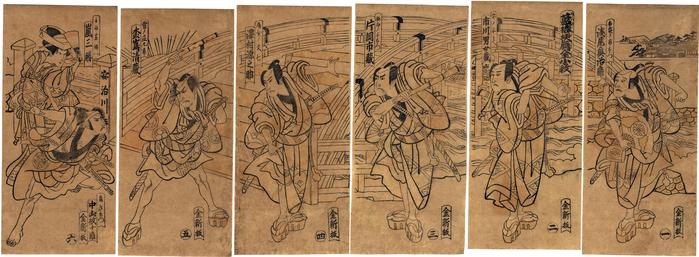Kappazuri-e: from right to left a member of the Asao clan (浅尾奥治?); Ichikawa Omezō I (市川男女蔵); Kataoka Ichizō I (片岡市蔵?); Sawamura Gennosuke I (澤村源之助); a member of the Matsui clan (松???); a member of the Nakayama Monjūrō (中山紋十郎) ; and Arashi Sankatsu (嵐三勝) in the female role
ca 1810
36 in x 13.5 in (Overall dimensions) woodblock print
Publisher: Honkichi
Metropolitan Museum of Art - 1838 Gakutei print of a stone bridge over the Aji River
Museum of Fine Artrs, Boston - Early 1840s Hiroshige of an Osaka scene of pedestrians on a bridge over the Aji River
Google maps - the Aji River in Osaka
A bridge was built over the Aji River in Osaka in the very last years of the 17th century. It was said to have been washed away by floods at least three times in 1791, 1854 and 1866. The bridge in this set of prints would be from its second iteration. Its length may have been approximately 255' long by about 14+' wide.
****
The Aji River is not very long and flows entirely within the confines of the city of Osaka. It flows into the bay which is also fed by the much larger Yodo River nearby. The Yodo is fed by the only water which runs out of Lake Biwa, about 40 miles to the northeast.
****
Six hosoban tate-e. Designs from this important first era of Osaka print-making are rare. Complete multiple sheet compositions like this have largely not survived. Almost certainly unique.
The title printed on the post on the far left, at the foot of the bridge, may read "Ajigawa bashi" or 'bridge over the river Aji' (安治川橋?).
The publisher's seal reads: 企新板.
John Fiorillo comments:
While the composition is indeed rare and you are most fortunate to have it in your collection, it is not by Ryukosai. Rather, it is an unsigned kappazuri-e (stencil print) from Kyoto.
Depicted are actors in one of the Karigane gonin otoko mono (Karigane's five-men plays). In real life, the Karigane gonin ('Karigane five') were members of a notorious loosely knit gang of at least eleven outlaws led by Karigane Bunshichi (he's depicted in sheet #4 in your hexaptych) who were executed on 8/26/1702 for a crime spree of beatings, theft, and murder spanning several years. These plays typically portrayed the criminals as so-called otokodate (chivalrous commoners, literally 'standing men'), mythologizing and transforming them from street thugs into heroes who fought against the oppression of townspeople by trouble-making samurai known as hatamoto yakko ('bannermen's footmen' serving the shogun). Very often in ukiyo-e, the Karigane gonin carry shakuhachi (long, end-blown wooden flutes ) and, indeed, all five outlaws in your hexaptych have these flutes, three seen behind their backs and two wielded as weapons. The outlaws are confronting Noda Kakuzaemon, a samurai patron of the pleasure quarters, and of young male actor-prostitutes in particular, who is murdered outside an Osaka theater by the Karigane gonin in a popular scene from a play by Takeda Izumo II titled Otokodate itsutsu karigane ('Karigane’s five brave and chivalrous men').
Kyōto-Osaka prints (kamigata-e - 上方絵) (genre)
actor prints (yakusha-e - 役者絵) (genre)
Ichikawa Omezō I (初代市川男女蔵: from 11/1789 to 6/1824) (actor)
Kataoka Ichizō I (初代片岡市蔵: from 1810 to 10/1858 and again 10/1859 to 5/1862) (actor)
Sawamura Gennosuke I (初代沢村源之助: 1/1791 to 10/1811) (actor)
Nakayama Monjūrō (中山紋十郎) (actor)
Otokodate - chivalrous men (男伊達) (genre)
